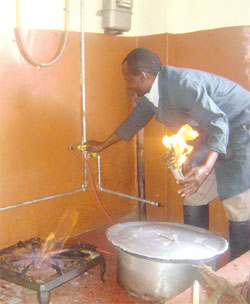By Peter Orengo
It may sound unpalatable but some institutions have found a way to solve the energy crisis with an at-home biogas digester that uses human waste.
While for many, human waste may be a stinky business, Meru Prison and Gachoire Girls Secondary School find it smelling like money. The institutions are saving money that would have gone into buying fuel of valuable money annually.
For Meru Prison, overpopulation has resulted in increased energy needs. Overcrowding leads to large amounts of human waste the prison cannot adequately process.
The officer in charge, Charles Mutembei says they used to spend more than half a million annually to buy firewood. When the idea of harnessing biogas from human waste was sold to them by the EU-GTZ and Sida partnership, they went for it.
"With a population of about 1,000 at our prisons, the system provides eight to nine hours of cooking gas," Mutembei said.
The test site at Gachoire Girls High School in Kiambu produces three to four hours of cooking gas.
"We can make quick meals for our teachers and students. That means we are saving more than Sh4000 per month," the school bursar told The Standard.
EU-GTZ and Sida are piloting a stand-alone biogas and hybrid up-flow baffle reactor systems, around Mt Kenya and Lake Victoria Basin.
Waste material
 |
A cook at Gachoire Girls High School prepares a meal using biogas. [PHOTOS: PETER ORENGO / STANDARD] |
A biogas digester, also known as a methane digester, is an equipment, which can turn organic waste into usable fuel. It relies on bacterial decomposition of biomass, waste material.
In addition to providing a source of renewable fuel, biogas digesters also provide low-cost fuel.
In a biogas digester, anaerobic digestion and fermentation is encouraged, and the gases are vented to a storage container. The resulting biogas can be burned as fuel for cooking, heating, and electricity generation. The sludge, which remains in the biogas digester after the fermentation process is complete, can be used for fertiliser.
According to Patrick Onyango, the project manager at GTZ, "Ordinarily, an individual uses 10,000 litres of water annually to flush toilets and these are laden with bio-solids that when treated through anaerobic processes, would yield beneficial biogas and reclaim bio-fertilisers."
Stay informed. Subscribe to our newsletter
Johannes Odhiambo, EU-GTZ Country Advisor says each person produces an average of 7.5kg of straight NPK per year.
For him, the twin problem of environmental degradation and low land productivity is compromising livelihoods through poor health and inadequate food provision.
That is why EU-GTZ/Sida funded Ecological Promotion Projects to improve sanitation principles to optimally treat human waste, and reclaim bio-energy and fertiliser for re-use in energy and agricultural production systems.
"Effluent, when treated correctly should meet the WHO/FAO standard, for restricted agricultural production on fruit and permanent crops," he says.
In Sweden, biogas is used to fire engines of public transport vehicles while Germany is generating more electricity from biogas-fired systems than the total generation capacity of Kenya.
These systems when used in an integrated manner could reduce depletion of water resources.
Cooking needs
Domestic waste when separated from industrial waste has potential in addressing water, fertiliser and energy needs with projections indicating that Nairobi could provide enough fertiliser laden water to produce a third of its food requirements, biogas to meet a third of its cooking needs at domestic levels and enough water to flush toilets for the city population with minor retrofitting of the existing plumbing system of the housing units.
 The Standard Group Plc is a
multi-media organization with investments in media platforms spanning newspaper
print operations, television, radio broadcasting, digital and online services. The
Standard Group is recognized as a leading multi-media house in Kenya with a key
influence in matters of national and international interest.
The Standard Group Plc is a
multi-media organization with investments in media platforms spanning newspaper
print operations, television, radio broadcasting, digital and online services. The
Standard Group is recognized as a leading multi-media house in Kenya with a key
influence in matters of national and international interest.
 The Standard Group Plc is a
multi-media organization with investments in media platforms spanning newspaper
print operations, television, radio broadcasting, digital and online services. The
Standard Group is recognized as a leading multi-media house in Kenya with a key
influence in matters of national and international interest.
The Standard Group Plc is a
multi-media organization with investments in media platforms spanning newspaper
print operations, television, radio broadcasting, digital and online services. The
Standard Group is recognized as a leading multi-media house in Kenya with a key
influence in matters of national and international interest.









